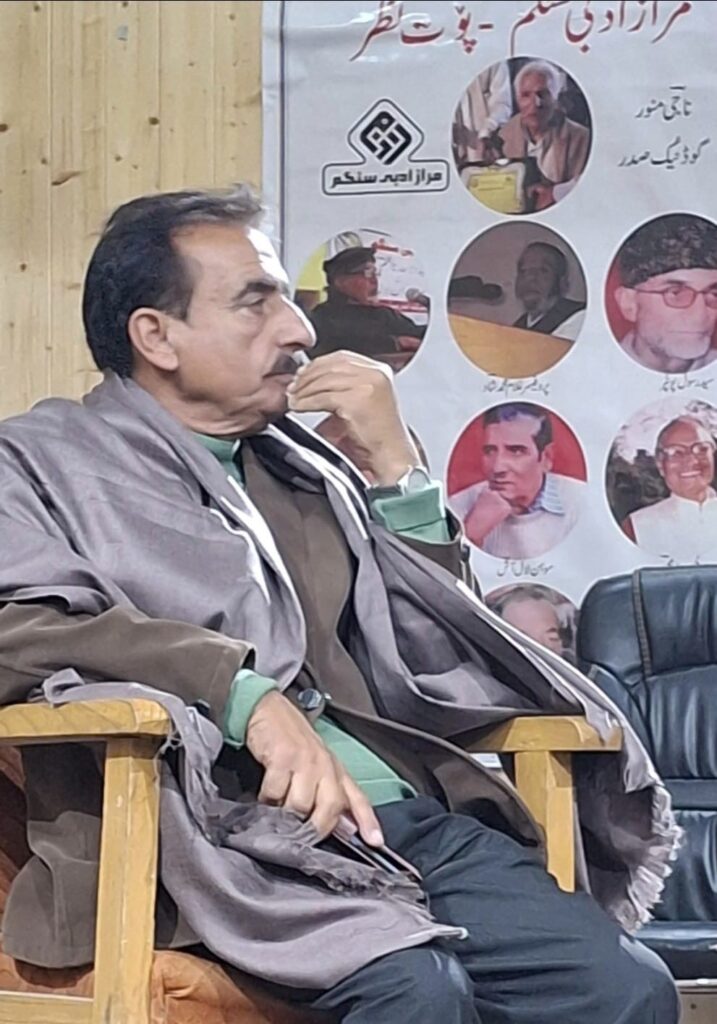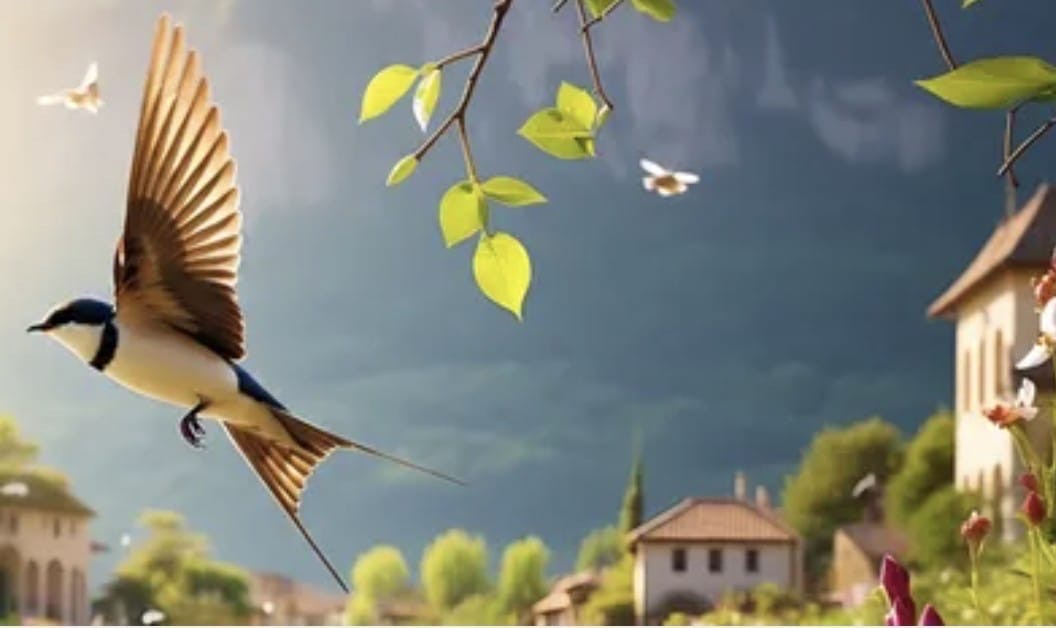Shad Ramzaan’s recent poem “Katej Mayani Gamitch (The swallow of my village ) seems on the surface a tender story of a swallow returning to her birthplace after years of absence. But like the bird herself katij in Kashmiri, the poem carries more than feathers and flight. It carries memory, longing, loss, displacement and perhaps most importantly, a quiet plea to remember what we once were as a people and as a place.

Not too far , just few decades back every spring in Kashmir, the swallow would return from faraway lands, settling into familiar nooks under roofs, welcomed by old hands and warm hearts. Families would help place food and water under her nest, children were told not to disturb her, and her arrival was seen as a blessing. It was part of the Valley’s own rhythm of seasons. And Shad Ramzaan, , taps into this cultural memory with great care , affection and artistic precession.
An old swallow (kataeij) returning to her home not to the songs , but to silence. She is, bewildered and numbed with the feeling to see everything changed . The courtyard of the home where she once nested is now covered in concrete. The old bubbling fountain (Naag) described by the oldest women of that home (deaed ) as lovelier than even Kashmir’s famed legendary Kounsar Naag lies choked with concrete dust.
Na samkaes su aangan daruk nagrathi
Dapaan aes daed Kousarus hoer kun Beh
Is how the poet describes the vanishing Naag and the astonishment and pain it brings to Kataej.
She finds the mesmerizing garden chorus of the birds especially Haer missing in the her courtyard . The melodious flute of bulbul on the window-pane, announcing evening visitors, is missing. Taekbatin, the spring flower that would burst through soil at the season’s call, “has forgotten to bloom. The window she once sat beside is shut, perhaps forever.
In fading day-light the swallow’s mind flits to kindly village souls now vanished: Saji pouf , the kind elederly lady , shielding a tumbler of milk beneath her cloak for her friend Beni-Tath,
Kakin, a Pandit lady visiting her muslim neighbor babitaeth in the evening , scattering handfuls of grain to sparrows and swallows . Their small generosities once stitched neighbour to neighbour; now they survive only in the bird’s brittle reverie. This is how Shad has coined words to describe the scene, our past glory, the days perhaps gone for ever.
Achun Tal yiyus wari hund hari chargish
Bichan ous yith dari paeth kari houl shouk bulbul
Wuchaan dari bar wati poetch cheer shamun
Ana saji pouf doud gilasa naris tal
Some noise over there . The swallows dream is broken. She is Startled awake, The day light is fading away and a dark night is ahead. She thinks , what If at all she lost her way , and. What If she must beg lodgings from strangers and they dishonor her., she broods, the shame will stain the whole village that forgot her nest.
So with these fears she pleads, “Babi-jaan,(the elderly Head of family) to open the window for her and let her rest in her own nest , which her beak shaped grain by grain years back .
Chi wan babi jaanus su motchrayi Meenis kothis dari pot ak
May owl chum shoormut yoormout behmi ratus
But no hand moves.
The silence that greets the swallow’s plea is not accidental—it is chosen.
Wanis kus bitchun bulbulun maecith gow babi jaanus
Tropun dari bhar kari wagnis makanus
Babi-jaan, the elder who once delighted in the rustle of her wings, has sealed shut the doors and windows of his once-hospitable home. The courtyard, once resonant with birdsong, has been reforged into a garage—symbol of a utilitarian age where memory has no market value. In Shad Ramzaan’s aching metaphor, the dismantled nest is not just a bird’s loss but a people’s quiet surrender.
Zamanun Wunus Oel Pratun ti protun
When time “told him to bring down the nest,” he blindly obeyed, not out of necessity but out of a subtle, creeping resignation to the present moment’s demands. He forgot that some nests are sacred—that in pulling down a swallow’s home, he has dislodged a part of his own history, his tration , his ethos which was the hall mark of unique Kashmir identity.
The final image the poet offers in the poem is simple , but it hits very hard.
Jorun naal Phernus ti damani rowus
Babi-jaan has embroidered the top opening—the neckline (naal)—of his pheran, making it appear elegant, refined, suited for display. But in the process, he has let go of the hem—damani—the bottom that once brushed against grass and spring soil. The soul of the garment, and by extension the soul of the land, is lost. Ramzaan doesn’t mourn just the aesthetic loss but a deeper displacement—the trimming of rootedness to suit surface beauty.
The swallow watches not just a home closed to her, but a world that has grown too glossy to carry warmath. The poem speaks not only of people who had to leave their homes, but also of lost connections, vanished voices, and the quiet erosion of cultural bonds, environmental hazards we are face to face with. Even as this review is being written, Kashmir is facing an unprecedented heat wave. Reports suggest many water bodies have shrunk, glaciers are depleting and the once pleasant climate of Kashmir has turned uncertain.
Shad Ramzaan doesn’t write with anger or accusation. His tone is elegiac, soft, but that softness carries a deep ache. He invites us to look around, not just with our eyes, but with memory and care. He asks us to remember the lives we used to live, where birds were part of the family, where neighbours shared grain and stories, where homes were not just structures, but spaces of warmth and welcome.
Stylistically, the poem walks a beautiful line—rich in metaphor but never too distant. It’s not weighed down by heavy language. It reads like a conversation between time and space, between what was and what is. It’s the kind of poem that doesn’t shout, but stays with you long after you’ve read it
A Swallow Comes Home is more than nostalgia. It is a wake-up call. A quiet reminder that memory is not enough—action must follow. We must stop build over our streams, care about our remaining bird species both local and migratory, and help recall all stories, songs, and silences that once made our Kashmir what it was.In that sense, the poem is not just about a bird. It is about us. About what we are losing, and what we still might be able to save, if only we listen.
And with that final, unanswered flutter of Kaetij outside the sealed window of her home , the poem leaves us with a question that hangs heavier than the bird’s own exhausted wings: in our rush to modernity, what have we quietly exiled?
There are great similarities I found in the poem with what willium wordsworth thought and wrote in his ever famous Ode: Intimations of Immortality from Recollections of Early Childhood
I will shake up your thought process with these famous lines from his ode;
“It is not now as it hath been of yore;—
Turn wheresoe’er I may,
By night or day.
The things which I have seen I now can see no more.”

This is a highly amazing piece of literature, but the swallow (Kateaj) of the times did not belong to our villages only, the bird equally lived in urban houses also and that too well inside the rooms with her mud nests on the underside of wooden roofs.
Many birds and other animals choose to be and many still are synanthropic. But the present human is fast trying to run away from its originality which is but fake. Nature is always powerful soon he shall have to surrender and later on realize the originality.